How to Design Around a Corner Fireplace
Sofas and chairs. A fireplace is an architectural focal point — and furniture is usually directed toward a room’s focal point. So why is it hard to find a couch facing a corner fireplace?
While every room is different, designers often advise against that layout, since it causes a couch’s corners to stick out awkwardly in the room, impeding flow. Instead, most designers orient a couch and rug parallel to a wall, as in this living room by architecture and design studio Hazelbaker Rush. A chair (or chairs) can then be placed at an angle, as pictured here.
Hot tip: Draw it! Map how you think you want your furniture arranged and how traffic is likely to flow through the room. Then make sure large and sharp-edged pieces of furniture aren’t in that path.
Another option: Place two chairs or a loveseat facing the fireplace and at 90 degrees in relation to the couch, to create an L shape, as pictured in this room uploaded by Gehan Homes. The feature wall here, facing the couch, is a secondary focal point with its grid pattern and artwork.
This room has a second seating area, which is a nice addition whenever space allows: Another armchair is next to the fireplace. It’s paired with a side table, creating a cozy reading spot that still feels connected to the conversation area.
Hot tip: Swivel chairs let you change your orientation from the conversation area to the television or the fireplace.
This room has a second seating area, which is a nice addition whenever space allows: Another armchair is next to the fireplace. It’s paired with a side table, creating a cozy reading spot that still feels connected to the conversation area.
Hot tip: Swivel chairs let you change your orientation from the conversation area to the television or the fireplace.
The furniture placement in this living room (in a photo uploaded by Martinez Hardwood Floors) was challenging, not just because of the corner fireplace but because of the large openings into the adjacent rooms and the busy travel path right through the middle of it all. To keep the path as clear as possible, the designers scaled down the rug, chose tailored pieces and pushed the couch and chair against the walls.
Hot tip: You’ll want at least 3 feet of width for paths of travel. If there’s a rug in that path, opt for a thin flat-weave and make sure there’s a nonslip pad underneath.
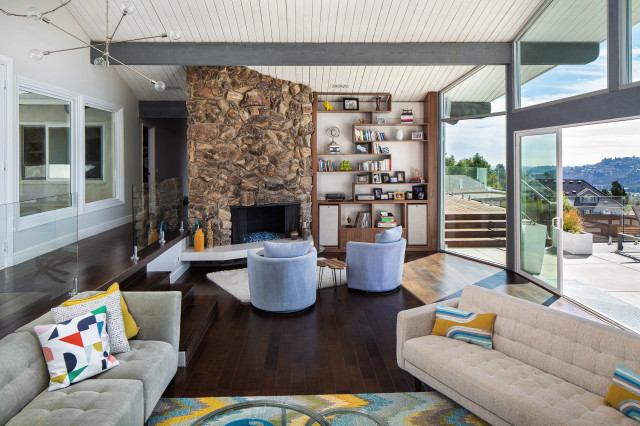
Hot tip: You’ll want at least 3 feet of width for paths of travel. If there’s a rug in that path, opt for a thin flat-weave and make sure there’s a nonslip pad underneath.

In a funky midcentury modern home remodeled by Metropolis Drafting and Construction, this sunken room has a pathway from the steps out to the sliding doors that essentially divides it into two, with seating areas on both sides.
The two barrel chairs facing the fireplace are perfectly positioned for a fireside tête-à-tête. With their rounded backs, they have no awkward corners to jut out into the pathway.
Hot tip: In addition to being easy to navigate around, rounded furniture, such as circular coffee tables and rounded-back chairs and sofas, also deemphasizes angles in awkwardly shaped rooms.
The two barrel chairs facing the fireplace are perfectly positioned for a fireside tête-à-tête. With their rounded backs, they have no awkward corners to jut out into the pathway.
Hot tip: In addition to being easy to navigate around, rounded furniture, such as circular coffee tables and rounded-back chairs and sofas, also deemphasizes angles in awkwardly shaped rooms.
Sectionals. Here’s an arrangement with an angled sectional instead of a traditional sofa, in a San Francisco Edwardian designed by Ann Lowengart Interiors. Not only is the angle conducive to conversation, but it creates a pleasing continuity with the angle of the adjacent fireplace.
Placing a chair directly in front of a fireplace is best avoided if possible. But it can work if the fireplace isn’t frequently used and the chair is visually light and easy to move out of the way.
Hot tip: In a small room used mainly for conversation, consider omitting a couch altogether. Instead, group four comfy club chairs around a circular coffee table in front of the fireplace.
Placing a chair directly in front of a fireplace is best avoided if possible. But it can work if the fireplace isn’t frequently used and the chair is visually light and easy to move out of the way.
Hot tip: In a small room used mainly for conversation, consider omitting a couch altogether. Instead, group four comfy club chairs around a circular coffee table in front of the fireplace.
How to Add a TV Into the Mix
On the adjacent wall. Optimal TV viewing height is eye level when the person is seated, and heat and electronics don’t mix. So placing a television above a console or a built-in entertainment unit versus above the fireplace mantel is often the best solution.
This transitional living room, designed by House of Funk, has a fireplace with an ornate mantel and a complementary television-and-studded-console combo. Because the fireplace and the entertainment center are on adjacent walls, those seated on the couch can enjoy both. Two additional chairs opposite the couch have been placed so they don’t block the view but do allow for conversation.
Hot tip: A neutral, monochromatic palette keeps a room with multiple focal points from looking cluttered.
On the adjacent wall. Optimal TV viewing height is eye level when the person is seated, and heat and electronics don’t mix. So placing a television above a console or a built-in entertainment unit versus above the fireplace mantel is often the best solution.
This transitional living room, designed by House of Funk, has a fireplace with an ornate mantel and a complementary television-and-studded-console combo. Because the fireplace and the entertainment center are on adjacent walls, those seated on the couch can enjoy both. Two additional chairs opposite the couch have been placed so they don’t block the view but do allow for conversation.
Hot tip: A neutral, monochromatic palette keeps a room with multiple focal points from looking cluttered.
Even though the television is the dominant focal point in this long living room by ULLE Studio, an angled sectional helps to invite the fireplace into the furniture grouping.
Hot tip: Echo the materials and design of your fireplace surround in other elements of your room to create a cohesive look.
Hot tip: Echo the materials and design of your fireplace surround in other elements of your room to create a cohesive look.
Here’s another room configured with the television on the wall adjacent to the corner fireplace. This time, the TV and cabinetry are nearly flush with the wall and topped with a mantel-like wooden header. That visual continuity, combined with the lounge-y sectional that spans them both, helps to make the two focal points feel more like one.
Hot tip: If your room’s proportions allow it, place the longest side of your sectional toward the focal point you want to emphasize.
Hot tip: If your room’s proportions allow it, place the longest side of your sectional toward the focal point you want to emphasize.
This rustic family room, by Michels Homes, also features a built-in entertainment unit adjacent to the fireplace wall, as well as a large sectional with equally comfortable views of both the television and the fireplace. When the television is off, it disappears into the dark wood, letting the fireplace take center stage.
Hot tip: Another way to avoid the big-black-box look is to use a Samsung Frame television, which resembles artwork when it’s off.
Hot tip: Another way to avoid the big-black-box look is to use a Samsung Frame television, which resembles artwork when it’s off.
On another wall. Doorways, windows and other architectural elements also can leave few places for the television. But wherever the TV ends up, the seating arrangement ideally will allow for comfortable viewing of both it and the fireplace, as is the case in this Southwestern-style living room by Metamorphosis.
Hot tip: When you have a corner focal point, populate the room’s other corners to create symmetry and balance, as the designer of this room did with the armchair.
Hot tip: When you have a corner focal point, populate the room’s other corners to create symmetry and balance, as the designer of this room did with the armchair.
Above the fireplace. The concept of placing the TV over the fireplace sparks a lot of debate in the design community. If you have a low, linear fireplace that doesn’t emit much heat, or if your seating is far away from the set, it can work well. But the configuration can be bad for your TV and a pain in the neck — literally and figuratively, as alluded to earlier. Be sure to read up on the topic before going this route.
But there’s no denying that installing a television above the fireplace is popular, and it has the advantages of being space-efficient and creating a single focal point in a room, as you can see in this room designed by Visbeen architects.
Hot tip. If you’re still scratching your head about where to put the TV, consider a pull-down screen and a projector.
But there’s no denying that installing a television above the fireplace is popular, and it has the advantages of being space-efficient and creating a single focal point in a room, as you can see in this room designed by Visbeen architects.
Hot tip. If you’re still scratching your head about where to put the TV, consider a pull-down screen and a projector.
How to Choose and Place a Rug
Rugs are great for grounding conversation groupings, but they can conflict with hearths and draw attention to awkward angles. The round rug in this French living room resolves the “In which direction should the rug go?” question.
Hot tip: Organically shaped rugs, such as hides and sheepskins (faux or real), and multiple rugs layered to create asymmetrical shapes also can help to ground a seating arrangement and add softness without having a distinctive directionality.
Rugs are great for grounding conversation groupings, but they can conflict with hearths and draw attention to awkward angles. The round rug in this French living room resolves the “In which direction should the rug go?” question.
Hot tip: Organically shaped rugs, such as hides and sheepskins (faux or real), and multiple rugs layered to create asymmetrical shapes also can help to ground a seating arrangement and add softness without having a distinctive directionality.
Designers usually advise having all furniture legs, just the front legs or no legs at all on top of an area rug. But this narrow French living room, designed by Anne Chemineau, has an unconventional furniture-and-rug layout, with the rug parallel to the corner fireplace but the couch and ottoman against the walls, and furniture legs going every which way.
Hot tip: Wainscoting or built-in cabinetry can help to spread out the visual heft of an ornate fireplace so the room feels more balanced.
Hot tip: Wainscoting or built-in cabinetry can help to spread out the visual heft of an ornate fireplace so the room feels more balanced.
This bright living room, by Jubilee Interiors, offers another example of a rug that’s parallel to the fireplace instead of the couch, though all of the sectional’s front legs appear to be on it. Were the rug placed parallel to the couch, the rug would have to be much smaller, to not run into the fireplace. So either option is a trade-off.
Here’s an effective way to avoid having your rug and hearth meet at an awkward angle, compliments of Christian Rice Architects: Sink the floor and carpet — the whole thing!
Hot tip: To prevent sparks and embers from lighting your rug on fire, place the rug at least 12 to 18 inches away from the fireplace and invest in a pretty fireplace screen. Flame-retardant hearth rugs are available as well.
Hot tip: To prevent sparks and embers from lighting your rug on fire, place the rug at least 12 to 18 inches away from the fireplace and invest in a pretty fireplace screen. Flame-retardant hearth rugs are available as well.
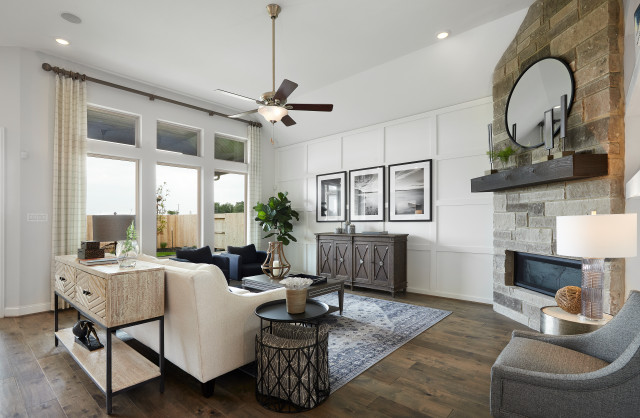






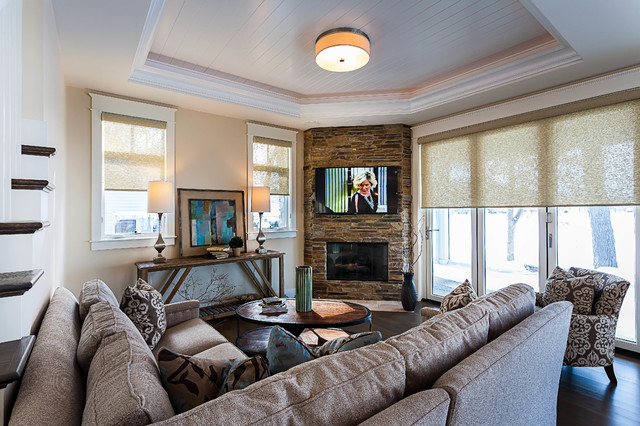

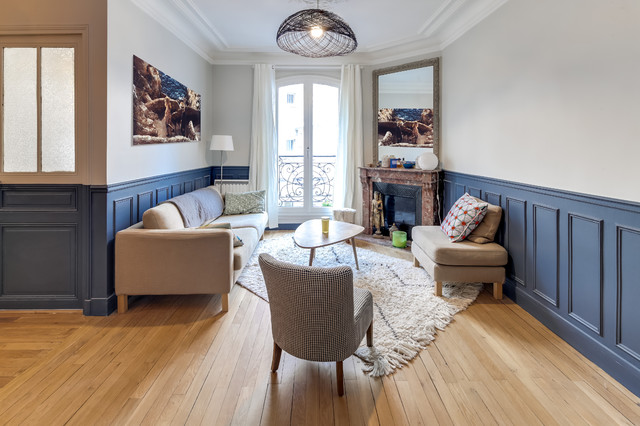

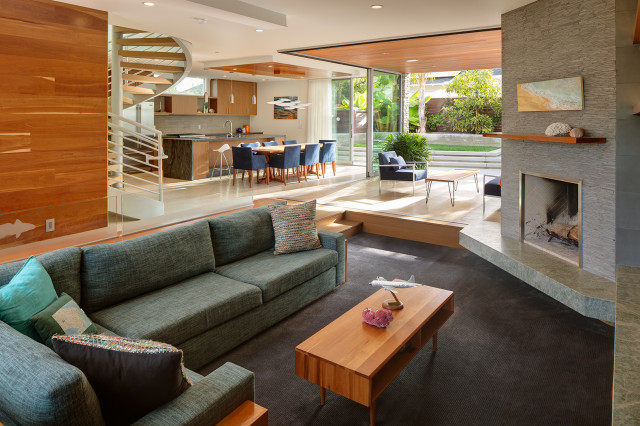
Comments
Post a Comment